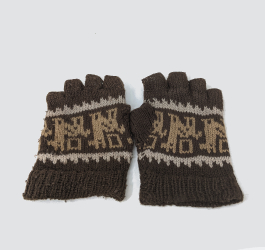Caring for your projects: Pilling

There is nothing worse than pulling out a favourite item and realizing that it has pills on the surface! Pilling (or bobbling) is when small balls of wool form on the surface of woollen items. Here, we will explain how different factors affect pilling, and how you can remove pills in your own items.
These mitts have been very well loved and worn often, but friction has led to the formation of pills all over the surface of the item. The pills even obscure the colourwork detail! On the right, you can see the item after de-pilling with a fabric shaver.
Why do items pill?
Pilling occurs in all woollen yarns: each strand of yarn is made of many tiny fibres plied together in one of many different ways. Over time and use, some fibres on the outermost surface of the yarn will come loose, and may gather together in little balls on the outside of your garment.
Yarn construction:
Different yarns are more prone to pilling. The tighter the twist of the yarn, the more pill resistant.
Stitch type:
Loose stitches with lots of eyelets, yarn overs or laces can all lead to more pilling. Even simple stocking stitch can pill! Denser knits like ribbing, seed or moss stitch, or garter stitch can give your garment extra pill-resistant powers!
Tension:
The looser your tension, the more a project will pill - with more space between each stitch, there's more room for the fibres to come loose. This is another reason that it is important to check your gauge whenever you begin a project.
Wear:
Friction on the surface of a project can cause extra pilling. Under the arms is a prime spot, as this area receives friction every time it is worn and the inside sleeve rubs against the body of the jumper.
Removing Pills
To depill a garment and remove the surface bobbles, you'll need a depilling tool. There are several main options people use:
- A handheld electric depiller/fabric like this one:; Ours is from the Fabric Care Company, but there are options available at your local yarn store, Big W, Bunnings, or online.
- A manual depiller/fabric comb
- A pumice stone
Whichever option you choose, ensure to follow the instructions, go slow, and test on an inconspicuous area first.
With proper care, your knit and crochet items will last a lifetime! Check out our blog archive for more tips on caring for your projects.



